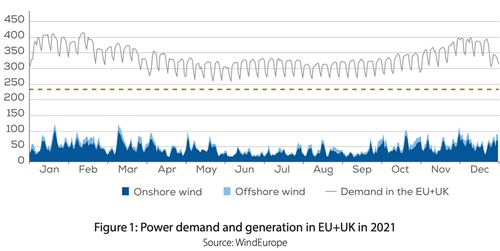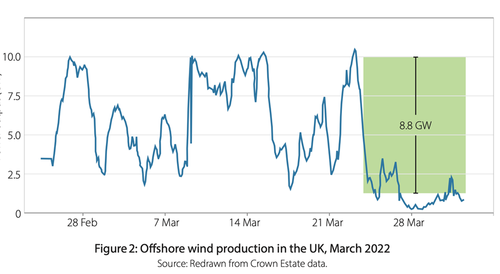Written by Chris Morrison via DailyScetic.org,
One could argue that the basic arithmetic showing that wind power is an economic and social disaster in the making should be clear to a bright elementary school kid. Now Oxford University mathematician and physicist, CERN researcher and Keble College Fellow Emeritus Professor Wade Allison has done the math. The UK faces the likelihood of a power failure, it concludes.
“Wind power fails on all fronts,” he says, and adds this governments are ignoring the “overwhelming evidence” of the inadequacies of wind power “and resorting to analysis rather than reason”.
Professor Allison’s dire warnings are contained in a short paper recently published by the Global Warming Policy Foundation. He points out that the energy provided by the Sun is “extremely weak”, and so it could not provide the energy to maintain even a small pre-Industrial Revolution world population with an acceptable standard of living. A similar point was recently made more dramatically by nuclear physicist Dr. Wallace Manheimer. He argued that the infrastructure around wind and solar will not only fail, but will cost trillions, pollute large portions of the environment, and be completely unnecessary.
In his role, Allison focuses on figuring out the numbers behind natural wind fluctuations. Full papers are not complicated and can be assessed from the link above. It shows that at a wind speed of 20 mph, the power produced by a wind turbine is 600 watts per square meter at maximum efficiency. To deliver the same power as the Hinkley Point C nuclear power station (3.2 billion watts), 5.5 million square meters of swept area per turbine would be required.
It should be noted that this should be quite unacceptable to those who care about birds and other environmentalists. Of course, that concern doesn’t seem to have materialized so far. Millions of bats and birds are estimated to be killed by land-based wind turbines each year. Meanwhile, off the coast of Massachusetts, work is about to begin on a giant wind farm, with permits to harass and injure nearly a tenth of the population of the rare North Atlantic right whale.
When wind speed fluctuations are factored into Allison’s formula, wind performance gets much worse. If the wind speed is halved, the available power is reduced by a factor of eight. Almost worse, he notes, if the wind speed doubles, the power delivered increases eightfold and the turbine must be shut down to protect itself.

The effect of the enhanced fluctuations is spectacular, as shown in the graph above. Nominal installed generation capacity in the EU and UK in 2021, shown by the brown dashed line, was 236 GW, but peak daily output was only 103 GW on 26 March. The unreliability is shown to even greater effect in the second graph depicting the wind generated offshore the UK in March last year.

For eight days at the end of the month, power generation was reduced, presumably, Allison says, because wind speeds were cut in half. The daily loss of 8.8 GW during the period was observed to be 1,000 times the capacity of the world’s largest grid storage battery at Moss Landings in California. When it comes to the huge batteries needed to store renewable energy, Allison points to safety issues as well as mineral shortages. Batteries will never compensate for the failure of offshore wind farms, not even for a week, and he notes that they can fail for much longer.
Others have recently looked more closely at the costs of battery storage. American lawyer and mathematician Francis Menton, who runs the Manhattan Contrarian site, reviewed recent official cost reports and found that “even under the most optimistic assumptions” the cost could be as high as the GDP of a country. Under less optimistic assumptions, the cost of capital alone could be 15 times annual GDP. Last year, Associate Professor Simon Michaux warned the Finnish government that there were not enough minerals in the world to supply all the batteries needed for Net Zero. Michaux noted that the Net Zero project may not work completely “as planned.” Meanwhile, Menton concluded, with a view that some might consider unduly charitable: “It’s hard to avoid the conclusion that the people planning the Net Zero transition have no idea what they’re doing.”
Professor Allison has done his sums based on basic physics and freely available information. “Either way, wind power is insufficient. It is intermittent and unreliable; it is exposed and vulnerable; it is weak with a short lifespan,” concludes

 has had enough of children’s hairdressing. “Kids shouldn’t be indoctrinated about anal sex. They shouldn’t be taught that changing genders is fun. They shouldn’t be afraid that their dad will suddenly become a woman.”
has had enough of children’s hairdressing. “Kids shouldn’t be indoctrinated about anal sex. They shouldn’t be taught that changing genders is fun. They shouldn’t be afraid that their dad will suddenly become a woman.” 